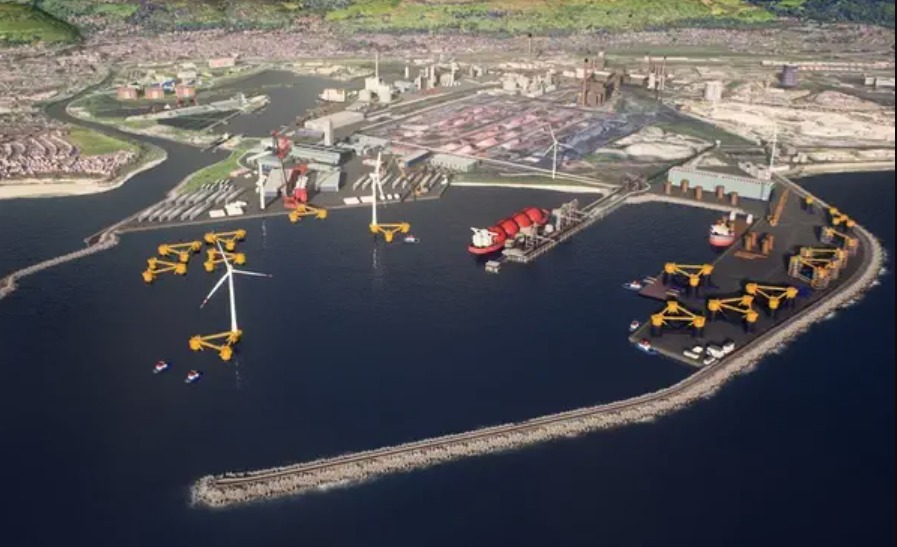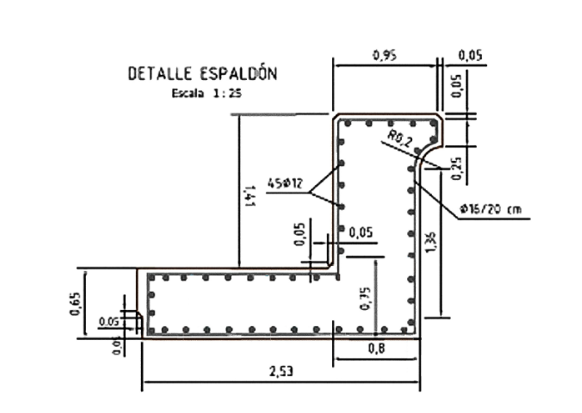Breakwaters are coastal structures designed to protect shorelines from flooding and erosion while enabling harbor activities. Among these, Rubble Mound Breakwaters are constructed with a core of quarry run, shielded from wave action by one or more layers of large stones or specially shaped concrete armor units.
A rubble mound breakwater can also include a parapet wall, built with reinforced concrete, serving two primary purposes: facilitating the safe transit of people and vehicles and mitigating overtopping during storm events.
Functionality of the breakwater in the integrated system
In this particular case, the breakwater serves as a key element in reducing wave action on both structures [1]:
- Reduction of wave forces and structural fatigue: Continuous wave loading is a critical factor influencing both the design (materials and dimensions) and the fatigue life of offshore structures. In this system:
- Offshore oil platforms are located in the calm waters created by the breakwater, reducing hydrodynamic loads.
- Wind turbines are installed directly on the breakwater, meaning their foundations have no direct contact with water, significantly lowering the structural stresses caused by waves.
- Lower probability of extreme marine conditions: The breakwater acts as a primary barrier, absorbing and dissipating wave energy before it reaches the offshore structures. As waves roll over the breakwater, they lose energy, reducing their impact on the protected area.
- Improved logistics for offshore operations: Sea state conditions pose a significant challenge during the construction, operation, and maintenance of offshore infrastructure. The breakwater plays a crucial role in mitigating these limitations by improving accessibility and reducing downtime.
- Offshore oil platform access is often restricted due to local wave conditions. A widely used parameter to assess accessibility is the significant wave height (Hs), as vessel access is typically prohibited when Hs exceeds 1.3 – 1.8 m. By dissipating wave energy, the breakwater creates calmer sea conditions, significantly reducing operational delays and ensuring that maintenance activities can be carried out more efficiently.
- Wind turbine access is further optimized, as they are constructed directly on the breakwater. With the addition of a crown wall, land-based vehicles can be used for maintenance, eliminating the reliance on ships and further streamlining logistics.
Materials and maintenance strategy
A key component of the rubble mound breakwater was selected to conduct a Life Cycle Assessment (LCA): the parapet wall. This structure plays a crucial role in the integrated system, as it mitigates overtopping during storm events while also facilitating the accessibility of land-based vehicles for wind turbine maintenance, eliminating the need for ships and streamlining logistics.
An LCA was performed to evaluate the environmental performance of three design alternatives for the parapet wall (summarized in Table 1), with a particular focus on their carbon footprint and overall contribution to climate change.
Among the three evaluated options, RC3, which incorporates GFRP reinforcement and recycled aggregates, demonstrated the lowest environmental impact. Although GFRP production generates some emissions, its lightweight properties help offset these effects by improving structural performance and reducing overall material consumption. For this reason, RC3 was selected for the parapet wall in this project. The cross-section, shown in Figure 2, was used to calculate the total volume of concrete and reinforcement required.
Since RC3 was chosen as the primary material for the integrated system, the maintenance plan was developed accordingly. Literature sources [4], [5] indicate that GFRP-reinforced concrete does not require major repair actions. In fact, after a 100-year service life, it is expected to retain up to 70% of its initial strength in similar structures. However, concrete in marine environments is still vulnerable to physical deterioration, primarily due to the water exposure (erosion, wetting and drying cycles) and biological activity (marine organisms affecting the surface).
To address these issues, concrete surface preservation measures called Concrete Surface Maintenance (CSM) were included in the maintenance plan:
- This action is planned for a 80-year lifespan of the structure.
- Maintenance consists of cleaning the surface and repairing minor defects every 5 years.
- The volume of material to be replaced corresponds to 1.5% of the total concrete volume. This estimate was based on 50% of the total concrete volume, considering deterioration effects and the reinforcement cover on the seaward side, which is more exposed to environmental degradation.
- The duration of maintenance interventions varies depending on the size and length of the breakwater and the environmental conditions (localized aggressiveness, material performance over time) and the construction quality. A preliminary estimation suggests that maintenance work could progress at a rate of 20 meters per day. For a 250-meter-long breakwater, this results in an estimated 13-day intervention period.
References
-
“Welsh Port Steps Closer to Becoming Floating Wind Hub.” Offshore Engineer, 30 Jan. 2024, https://www.oedigital.com/news/512596-welsh-port-steps-closer-to-becoming-floating-wind-hub.
-
Cejuela, Eduardo, Vicente Negro, and Jose María del Campo. “Evaluation and Optimization of the Life Cycle in Maritime Works.” Sustainability, vol. 12, no. 11, 2020, doi:10.3390/su12114524, https://www.mdpi.com/2071-1050/12/11/4524.
-
Younis, Adel, Usama Ebead, and Simon Judd. “Life Cycle Cost Analysis of Structural Concrete Using Seawater, Recycled Concrete Aggregate, and GFRP Reinforcement.” Construction and Building Materials, vol. 175, June 2018, pp. 152–160, doi:10.1016/j.conbuildmat.2018.04.183.


